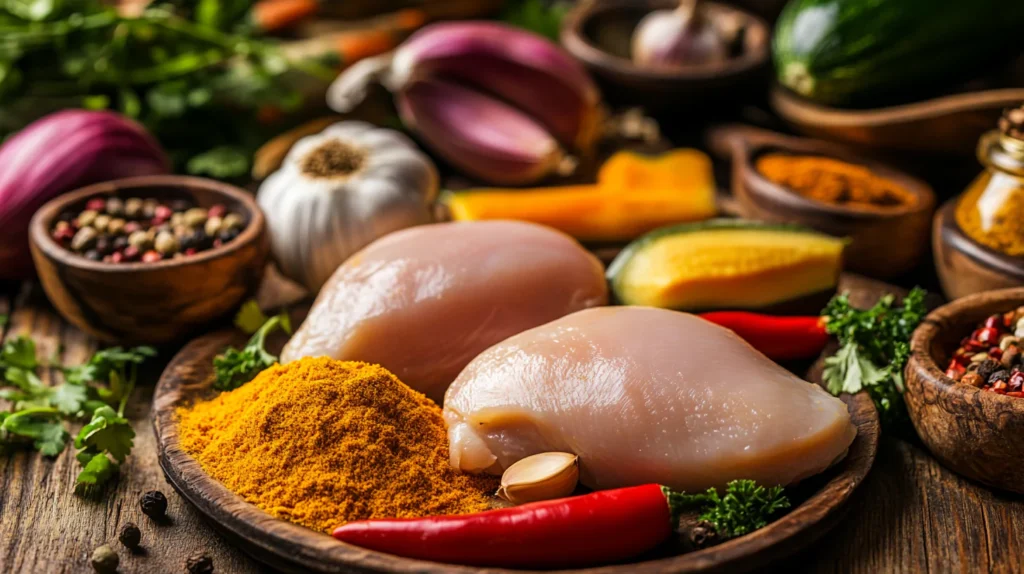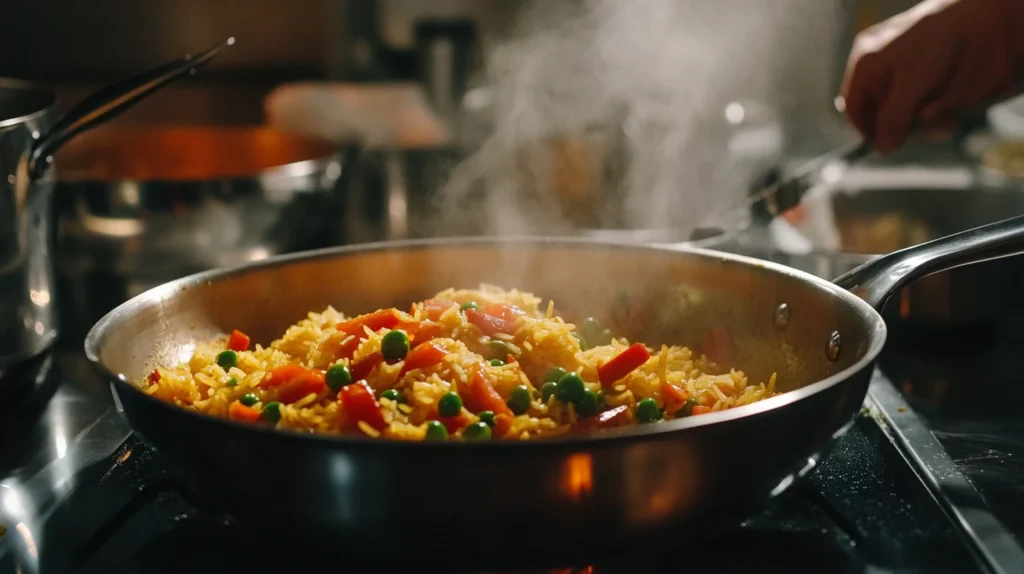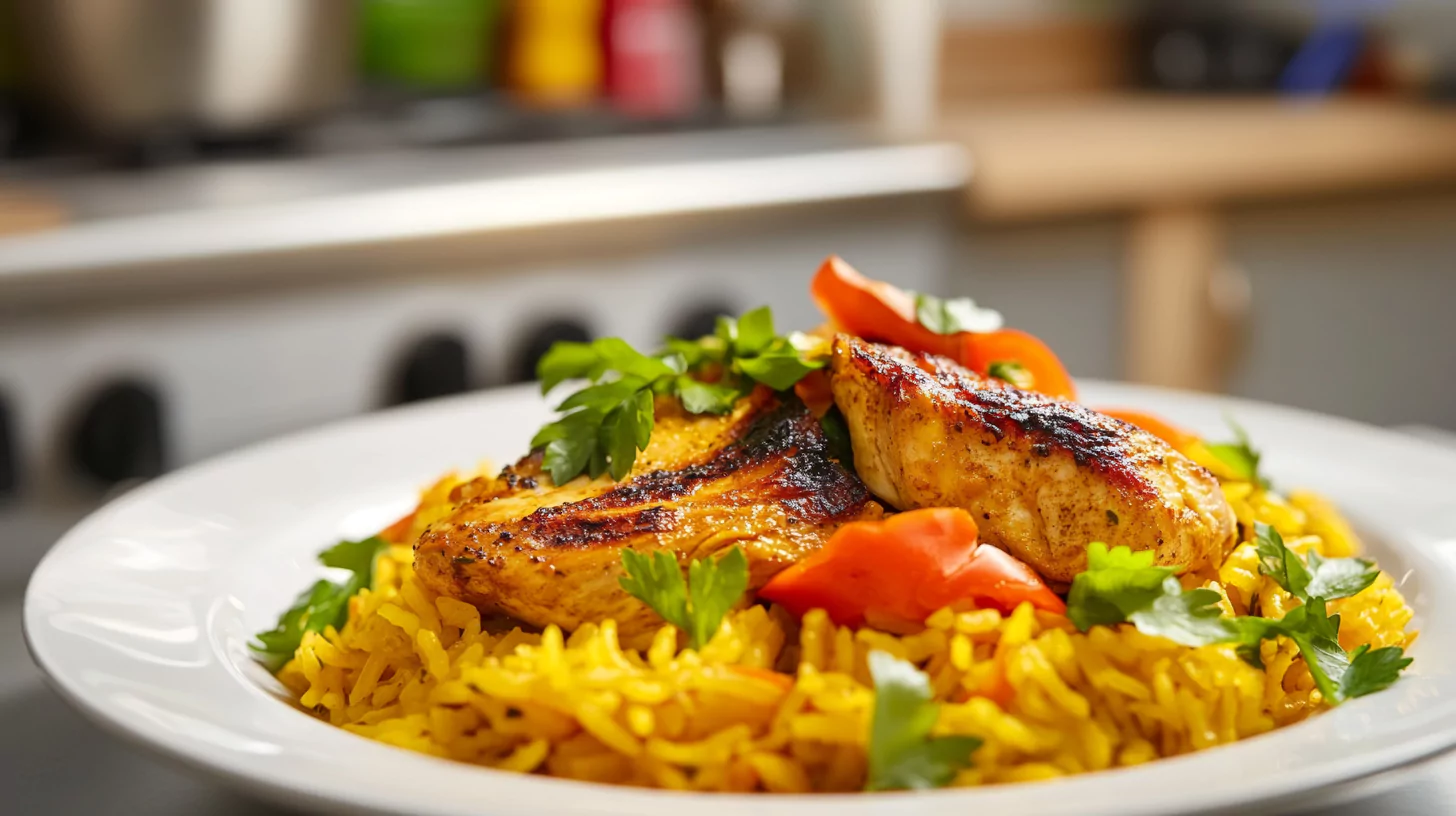Is yellow rice and chicken healthy? This popular dish, loved for its flavor and vibrant appearance, has become a staple in many kitchens worldwide. Often featuring spices like turmeric or saffron, yellow rice adds a burst of color and a unique taste to meals, while chicken provides lean protein essential for muscle growth and repair. Depending on how it’s prepared, this dish can be a well-balanced and nutritious meal, combining carbohydrates, protein, and essential nutrients in one plate.
Yellow rice and chicken is versatile and can be adapted to various dietary needs, from weight management to muscle-building diets. However, its healthiness often depends on factors such as portion sizes, ingredients, and cooking methods. By making the right choices, this comforting dish can be transformed into a wholesome, nutrient-packed option.
If you’re looking for inspiration, check out this delicious chicken and yellow rice recipe for a flavorful and healthy way to enjoy this meal.
In this article, we’ll explore the nutritional profile of yellow rice and chicken, its health benefits, potential downsides, and practical tips to make it even healthier for your lifestyle.
Is Yellow Rice and Chicken Healthy? A Look at Its Nutritional Profile

What Makes Yellow Rice Healthy?
Yellow rice is a flavorful variation of white or brown rice, typically cooked with turmeric, saffron, or annatto to give it its distinctive golden hue. These ingredients not only add color but also contribute health benefits. For example:
- Turmeric: A potent anti-inflammatory and antioxidant-rich spice.
- Saffron: Known for its mood-enhancing properties and essential minerals.
- Annatto: High in carotenoids, supporting eye health and immune function.
The nutritional content of yellow rice depends on the type of rice used. White rice is lower in fiber and nutrients compared to brown rice, which is a whole grain and retains more vitamins and minerals.
Nutritional Benefits of Chicken in Yellow Rice Dishes
Chicken, especially lean cuts like chicken breast, is an excellent source of high-quality protein. It is low in fat when skinless and provides essential nutrients like:
- Protein: Vital for muscle repair, immunity, and overall body function.
- B Vitamins: Particularly B6 and niacin, which aid energy production and brain health.
- Minerals: Including phosphorus and selenium, which support bone health and immunity.
Dark meat like chicken thighs adds more flavor and fat, which can be beneficial in moderation, but may not be ideal for those monitoring caloric intake.
Combination Benefits
When combined, yellow rice and chicken form a nutritionally balanced meal. The dish provides:
- Carbohydrates for energy.
- Protein for muscle building and repair.
- Essential vitamins and minerals to support various bodily functions.
By adding vegetables like carrots, peas, or bell peppers, the dish becomes even more nutrient-dense, enhancing its fiber and antioxidant content.
What Are the Health Benefits of Yellow Rice and Chicken?
High Protein from Chicken
Chicken is a top-tier protein source, particularly for those who want to build or maintain muscle. Protein is also filling, making meals satisfying and preventing overeating.
- Weight management: High-protein diets have been shown to support weight loss by reducing hunger and boosting metabolism.
- Bone health: Protein works with minerals like phosphorus in chicken to maintain strong bones.
Vitamins and Minerals in Yellow Rice
The spices in yellow rice, such as turmeric and saffron, bring more than just taste. They contribute:
- Anti-inflammatory properties: Turmeric helps reduce inflammation, beneficial for those with arthritis or chronic conditions.
- Mood support: Saffron has been linked to reducing symptoms of mild to moderate depression.
Whole-grain rice options, like brown or wild rice, add fiber that supports digestion and heart health.
A Balanced Meal Option
Yellow rice and chicken offer a balance of macronutrients: carbohydrates, protein, and fat. When paired with healthy fats (e.g., olive oil) and vegetables, this dish provides:
- Sustained energy: Perfect for active individuals or those needing a mid-day energy boost.
- Nutritional variety: Ensuring essential vitamins and minerals for overall well-being.
Is Yellow Rice and Chicken Healthy? Understanding Its Downsides
Caloric Concerns
While yellow rice and chicken can be part of a balanced diet, the calorie content depends on preparation methods and portion sizes. Key considerations include:
- Rice-to-chicken ratio: A higher proportion of rice can increase calorie intake due to its carbohydrate density.
- Cooking oil: Using excessive amounts of oil or butter adds unnecessary calories and saturated fat.
To manage calorie content, it’s essential to focus on portion control and use healthy cooking methods like baking, grilling, or steaming.
Sodium Levels in Store-Bought Versions
Many pre-packaged yellow rice mixes and seasoning packets contain high levels of sodium. Consuming too much sodium over time can lead to:
- High blood pressure: A risk factor for cardiovascular disease.
- Fluid retention: Causing bloating and discomfort.
Choosing homemade recipes allows for better control over sodium levels by using fresh spices and herbs instead of processed seasonings.
Dietary Restrictions
Certain individuals might face dietary challenges with yellow rice and chicken:
- Low-carb diets: Yellow rice is rich in carbohydrates, which may not fit into ketogenic or low-carb eating plans.
- Vegetarian or vegan diets: Chicken excludes this dish from plant-based meal plans, although substitutions like tofu or chickpeas can work.
- Food allergies: Some may have sensitivities to ingredients like saffron or turmeric.
To ensure inclusivity, alternative ingredients or modifications can make the dish suitable for different dietary needs.
Tips for Making Yellow Rice and Chicken Healthier
Choose Healthier Rice Options
The type of rice used significantly impacts the dish’s nutritional profile. Opt for:
- Brown rice: Higher in fiber and nutrients than white rice.
- Cauliflower rice: A low-carb substitute for those watching their carbohydrate intake.
- Wild rice: Rich in antioxidants and protein.
These alternatives enhance the health benefits of yellow rice without sacrificing flavor.
Use Lean Chicken Cuts
For a lower-fat meal, opt for skinless chicken breast over thighs or drumsticks. Additionally:
- Trim visible fat: Even small reductions in fat can make a significant difference.
- Marinate with healthy ingredients: Lemon juice, garlic, and olive oil add flavor without extra calories.
Reduce Sodium and Fat
To minimize unhealthy components, consider:
- Homemade seasoning: Use turmeric, saffron, garlic powder, and paprika instead of store-bought mixes.
- Healthy fats: Replace butter with olive or avocado oil.
Add More Vegetables

Incorporating vegetables like carrots, peas, zucchini, or bell peppers boosts fiber, vitamins, and minerals. This adds color, texture, and nutritional variety to the dish.
- Leafy greens: Serve the dish with a side of spinach or kale for added antioxidants.
- Legumes: Lentils or chickpeas can enhance protein and fiber content.
Yellow Rice and Chicken in Different Diet Plans
Role in Weight-Loss Diets
Yellow rice and chicken can be part of a calorie-conscious diet with proper portion control. For weight loss:
- Adjust rice portions: Reduce the amount of rice and increase the vegetable or chicken ratio.
- Healthy cooking techniques: Bake or grill chicken and steam rice with minimal oil.
Incorporation into Balanced Meals
This dish fits well into balanced meal plans, particularly when combined with healthy sides. For example:
- Mediterranean diet: Pair yellow rice and chicken with olive oil and a fresh salad.
- Meal prep: The dish stores well and can be portioned for lunches throughout the week.
Cooking Tips for a Healthy Dish
Use of Spices and Natural Ingredients
The right combination of spices can elevate the flavor and nutritional value of yellow rice and chicken without relying on artificial additives. Consider:
- Turmeric and saffron: Not only for color but also for their anti-inflammatory and antioxidant properties.
- Garlic and onions: Add depth of flavor and support heart health.
- Herbs like parsley and cilantro: These fresh herbs enhance taste and provide additional vitamins.
Avoid pre-packaged spice blends with high sodium or added preservatives.
Cooking Methods for Retaining Nutrients
The way yellow rice and chicken is prepared plays a crucial role in preserving its health benefits. Healthier methods include:
- Grilling or baking the chicken: These methods use little to no oil while keeping the chicken juicy and flavorful.
- Cooking rice in low-sodium broth: This adds flavor without excess salt.
- Steaming or sautéing vegetables lightly: This retains their natural nutrients and crunch.
Avoid Common Pitfalls
To maintain the healthiness of the dish, avoid these common mistakes:
- Overcooking rice: This can cause a mushy texture and reduce its glycemic index benefit.
- Using too much oil: Opt for a cooking spray or measure oil carefully to avoid unnecessary calories.
- Skipping vegetables: Ensure a mix of colorful veggies for balanced nutrition and added fiber.
FAQs
Is Yellow Rice and Chicken Good for Weight Loss?
Yes, yellow rice and chicken can be suitable for weight loss when prepared with healthy methods. By using lean chicken cuts, reducing portion sizes of rice, and incorporating vegetables, it becomes a filling, nutrient-dense meal that supports weight management.
Is Yellow Rice and Chicken a Complete Meal?
Yellow rice and chicken can be a complete meal when paired with vegetables or legumes. The combination of carbohydrates, protein, and essential vitamins provides a balanced nutritional profile. Adding healthy fats like avocado or olive oil enhances its overall health benefits.
Can Yellow Rice and Chicken Fit into a Low-Carb Diet?
Traditional yellow rice may not fit into strict low-carb diets due to its carbohydrate content. However, substituting regular rice with cauliflower rice or reducing the portion size of yellow rice can make it suitable for a lower-carb lifestyle.
Is Homemade Yellow Rice and Chicken Healthier Than Store-Bought?
Yes, homemade versions are healthier because they allow control over ingredients and cooking methods. Homemade yellow rice can be made with natural spices and less sodium, while fresh chicken ensures fewer preservatives and additives.
What Vegetables Pair Best with Yellow Rice and Chicken?
Vegetables like carrots, peas, bell peppers, broccoli, and spinach pair excellently with yellow rice and chicken. These vegetables add fiber, vitamins, and antioxidants, complementing the dish’s flavor and nutritional value.
Can This Dish Be Meal-Prepped?
Absolutely! Yellow rice and chicken is ideal for meal prep. It stores well in airtight containers and can be reheated without losing much flavor or texture. To prevent dryness, store chicken and rice separately and add a bit of broth or water when reheating.
Conclusion
Yellow rice and chicken is a versatile and flavorful dish that can be made healthy with the right choices (What Pairs Well with Yellow Rice?). Its combination of carbohydrates, protein, and essential nutrients makes it a balanced meal option suitable for various lifestyles and dietary needs.
By opting for whole-grain rice, lean chicken cuts, and natural seasonings, you can enhance its health benefits while reducing potential downsides like excess calories and sodium. Incorporating vegetables and using healthier cooking methods ensures this dish remains both delicious and nutritious.
Whether you’re aiming for weight loss, meal prep, or simply a wholesome family dinner, yellow rice and chicken can be a satisfying and health-conscious choice.


1 thought on “Is Yellow Rice and Chicken Healthy?”